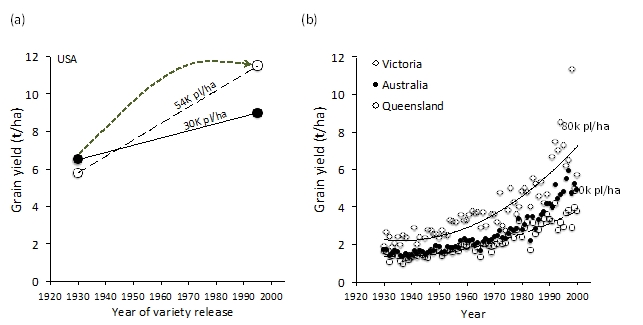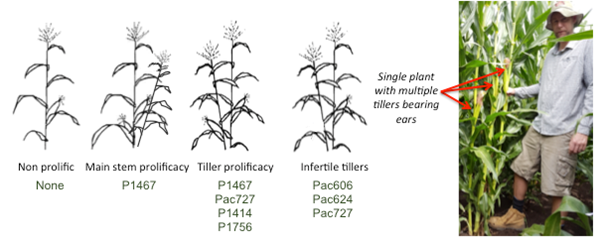Managing climate risk in rainfed maize with multi cobbing hybrids
Author: Daniel Rodriguez, Joe Eyre and James McLean, Queensland Alliance for Agriculture and Food Innovation (QAAFI) The University of Queensland | Date: 07 Mar 2017
Take home messages
- Prolific multi cobbing hybrids planted at low plant population 2-3pl/m2 can compensate yield during good seasons and save on seed costs.
- There are important differences between hybrids, environments and managements on the expression and benefit of the multi cobbing trait. In early plantings, or when planted in cooler environments at low plant densities tiller cobs can contribute up to 48% of the total grain yield. In warmer environments (Central Queensland) tillers are less likely to develop a grain-bearing cob, and are considered to be a waste of resources.
- Even though tiller cobs may contribute to yield, they are half as efficient as main stem cobs at producing grain (low tiller harvest index), and tillers can develop grains outside the husk leaves and these cobs have poor grain quality. Seed companies should consider these as undesirable traits that should be bred out of current hybrids.
- Given the diversity of maize growing environments, there is need for eco-physiology work to develop better-adapted maize plant ideotypes in close collaboration with seed companies.
Background
Increases in maize yield are the result of improvements in breeding (G), agronomy (M), the farming system, and their interactions. For example, over the last 70 years in the USA, the interaction between crop improvement and management, such as increased plant population, have doubled maize yields from under 6t/ha to just below 12t/ha (Fig 1a). These results contrast with those in Australia, particularly for the Northern Grains Region where maize is mostly grown under rainfed conditions at very low plant populations (Fig 1b). In the Northern Grains Region, the uncertainty of rainfall around flowering, heat stress and high seed costs, force rainfed (but also irrigation) farmers to sow maize at low plant populations (20-40K pl/ha), missing out on GxM interactions observed in in the USA using modern hybrids. Multi cobbing or prolific maize hybrids i.e. hybrids that develop a second or longer cob in the better seasons, have been proposed to compensate yield when sown at low plant populations.
To understand how Australian commercial hybrids and management interact when maize is sown across diverse environments in Queensland, we run two years of replicated trials including five sites, up to twelve hybrids per site, three to four plant densities, and solid (1m) and wide (1.5m) configurations.

Figure 1. (a) Maize yield for old and new hybrids sown at old (30k pl/ha) and modern (54k pl/ha) plant populations in the USA (Adapted from Fischer, 2014). The dotted green line shows the combined benefit (interaction) from using new hybrids sown at higher densities. (b) Time series of maize yields for Victoria – mostly irrigated (open diamonds), Australian average (filled circles), and Queensland – mostly rainfed (open circles), (Source ABS, 2015).
Results in Figure 2a show that the difference between the lowest and highest treatment yields (combination of hybrid x density x configuration) was up to 70% (Fig 2a); representing a 2.4 fold change in water use efficiency (WUE; from 7 kg/mm/ha to 17 kg/mm/ha) (Fig. 2b).
These two graphs are important as they indicate that:
(i) yield in maize is not all about agronomy or hybrid selection alone; what really matters is that we understand how to match hybrid type and management across the different environments of the Northern Grains Region;
(ii) identifying the optimum combination of hybrid and management can increase water use efficiency by up to a 2.4 fold; and

Figure 2. (a) Treatment yields (kg/ha) versus average site yields (kg/ha); and (b) Treatment yields (kg/ha) versus soil available water (mm) across NSW and Qld sites.
(iii) even though yields were has high as 13t/ha at the best sites, maximum maize yields and water use efficiencies appear to be lower than those observed with sorghum; note the dashed maximum 20 kg/mm/ha line obtained with sorghum across similar environments, versus the 17 kg/mm/ha line for maize in Fig 2b. This suggests that genetic improvement in maize in Australia might be lagging behind that of sorghum, or that the hybrids available in the market are not able to yield optimally when grown at the typically low plant densities of the mostly dryland cropping systems of the Northern Grains Region (Fig 1b).
We also found that when planted at low plant populations multi cobbing hybrids can compensate yield in high productivity environments or good seasons (Fig 3.). This provides opportunity to (1) use lower populations to reduce water use early during canopy development and save water for the critical stages of kernel set around flowering in average and poor seasons; (2) maintain the capacity to produce extra cobs and yield in the better seasons; and (3) save up to 50% in seed costs, ca. $130/ha. Increasing plant population though, will rapidly reduce multi cobbing in maize (Fig 3).

Figure 3. Maize yields versus cob number per plant for four hybrids showing contrasting degree of multi cobbing sown at three plant populations, 25,000, 50,000 and 70,000 pl/ha, in Gatton, Qld during the 2014/15 season. Open and closed symbols are for low (rainfed) and high productivity (irrigated) treatments, respectively.
Australian commercial hybrids show different types of yield formation characteristics, for example the capacity of plants to increase kernel numbers in good environments or seasons is called prolificacy (Fig 4.). Multi cobbing hybrids are one of these types. We found that very few hybrids will develop a secondary cob on the main stem (main stem prolificacy); while most hybrids will produce tillers (suckers), some of which may develop fertile cobs (we call this tiller prolificacy). Farmers consider tillering an undesirable trait, though under some circumstances tiller prolificacy can contribute up to 48% of the final grain yield (Table 1).

Figure 4. Conceptual representation of most common hybrid types available in the Northern Grains Region. Hybrid x Management x Environment interaction may change hybrid’s expression of the prolificacy trait.
We also identified so-called flex types, where under good conditions some hybrids will set more kernels on main stem cobs i.e. usually having more kernel rows. Table 1 summarises the characteristics of some commercial hybrids in terms of their potential contribution from main stem prolificacy (multiple cobs on the main stem), tiller prolificacy (multiple cobs on multiple stems), and flex (main stem primary cobs with more kernels in good conditions). For example P1467 and P1070 were found to be the only hybrids that produced a secondary cob on the main stem that contributed up to 30% to the total yield. P1467, and Pac727 have the potential to produce a large proportion of the yield (up to 50%) on tiller cobs; while Pac606 and P1070 showed the largest capacity to set more kernels on longer primary cobs under good conditions. All tested hybrids tend to produce infertile tillers.
Table 1. Characteristics of some commercially available maize hybrids in terms of prolificacy, defined as the capacity of some hybrids to increase kernel number under good conditions. Main stem and tiller prolificacy refers to hybrids that produce multiple cobs on the main stem, or on multiple stems, respectively. Primary cob flex refers to the maximum kernel number on the main stem cob. All hybrids will produce tillers.
|
Hybrid |
Main stem prolificity (Potential contribution to yield %) |
Tiller prolificity (Potential contribution to yield %) |
Infertile tillers |
Primary cob flex (Maximum primary cob kernel number) |
|
P1070 |
31 |
18 |
Yes |
1016 |
|
P1467 |
29 |
48 |
Yes |
975 |
|
Pac606 |
6 |
5 |
Yes |
1022 |
|
Pac727 |
4 |
37 |
Yes |
674 |
|
Pac624 |
3 |
2 |
Yes |
769 |
Conclusion
- Prolific hybrids planted at low plant population 2-3pl/m2 can compensate yield during good seasons; reduce water use early in the season; and save on crop establishment costs.
- There are important differences between hybrids, environments, managements and GxExM interactions on the expression of different types of prolificacy.
- In early plantings, or when planted in cooler environments at low plant densities tiller cobs can contribute up to 48% of the total grain yield. In warmer environments (Central Queensland) tillers are less likely to develop a grain-bearing cob.
- Even though tiller cobs may contribute to yield, they are half as efficient as main stem cobs at producing grain, and should be considered an undesirable trait by seed companies.
- Given the diversity of maize growing environments, there is need for eco-physiology work to develop better-adapted maize plant ideotypes in close collaboration with seed companies.
Acknowledgements
The research undertaken as part of this project is made possible by the significant contributions of growers through both trial cooperation and the support of the GRDC and ACIAR; the authors would like to thank them for their continued support.
Contact details
A/Prof Daniel Rodriguez
QAAFI, Centre for Plant Sciences https://qaafi.uq.edu.au/centre-for-plant-science
Ph: 0434 075 094
Email: d.rodriguez@uq.edu.au
GRDC Project Code: UQ00075,
Was this page helpful?
YOUR FEEDBACK
